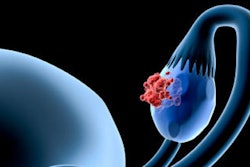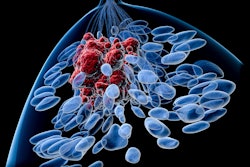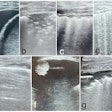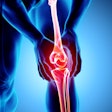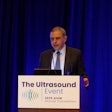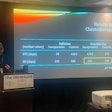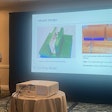Combining ultrasound features and immune-inflammatory markers could help predict axillary lymph node metastasis (ALNM) in breast cancer patients, according to research published June 24 in Academic Radiology.
A team led by Fenglin Dong, MD, from the First Affiliated Hospital of Soochow University in Suzhou, China, highlighted the performance of its nomogram, based on contrast-enhanced ultrasound (CEUS) and immune-inflammatory marker data. The nomogram demonstrated high accuracy in predicting ALNM in women with breast cancer.
“We constructed a newly effective model for the prediction of ALNM … which provides an alternative option for breast cancer patients in the early stage and demonstrates its potential in practical clinical applications,” Dong and co-authors wrote.
Accurately predicting ALNM is important for guiding treatment strategies in women with breast cancer. Furthermore, there is a desire among researchers in this area to develop a noninvasive predictive technique that doesn’t require biopsy or surgery.
The study authors suggested that CEUS can help by detecting tissue microvascular perfusion and providing more hemodynamic parameters except for morphological features, enhancing the contrast between blood vessels and breast tissues. Previous studies suggest that several ultrasound imaging characteristics of primary breast tumors are tied to ALNM.
Dong and colleagues studied the diagnostic performance of CEUS combined with immune-inflammatory markers in predicting ALNM in breast cancer patients.
The team used data collected between 2020 and 2023 from 401 breast cancer patients who underwent biopsy or surgery. The group used clinicopathological data and ultrasound features to create the nomogram. The researchers randomly divided the women into a training set (n = 321) and a validation set (n = 80).
The nomogram is based on three established models, including a clinical model (SII + CA125 + Ki67 + pathological type), an ultrasound model (lesion size + enhancement pattern + BI-RADS category), and a combined model (clinical + ultrasound).
Through logistic regression analysis, the team reported that the following characteristics were significant risk factors for ALNM:
- Systemic immunoinflammatory index (SII)
- CA125, Ki67, pathological type, lesion size, enhancement pattern
- BI-RADS category
The combined model performed better than the clinical and ultrasound models on both test and validation sets.
| Performance of models in predicting ALNM in breast cancer patients | |||
|---|---|---|---|
| Clinical model | Ultrasound model | Combined model | |
| Test set | |||
| Area under the curve (AUC) |
0.74 | 0.75 | 0.82 |
| Sensitivity |
76.7% | 76.7% | 66.7% |
| Specificity | 64.7% | 60.7% | 82.1% |
| Validation set | |||
| AUC | 0.79 | 0.78 | 0.9 |
| Sensitivity | 86.7% | 50% | 90% |
| Specificity | 70% | 96% | 80% |
The researchers constructed their nomogram based on the combined model to visualize the prediction results and the proportion of each factor. They reported that the calibration curves of the nomogram showed high agreement of predicted ALNM with the actual probability in the training and validation cohorts. Additionally, decision-curve analysis showed that the nomogram added more net benefits in predicting ALNM.
The study authors called for a “quantitative and effective way” to explore conventional ultrasound and CEUS images. This may include incorporating advanced technologies such as radiomics and deep learning to derive more insightful ultrasound parameters.
They added that future studies should focus on assessing the underlying mechanisms linking inflammation and ALNM, as well as exploring potential therapeutic interventions targeting immune-inflammatory pathways.
The full study can be found here.




